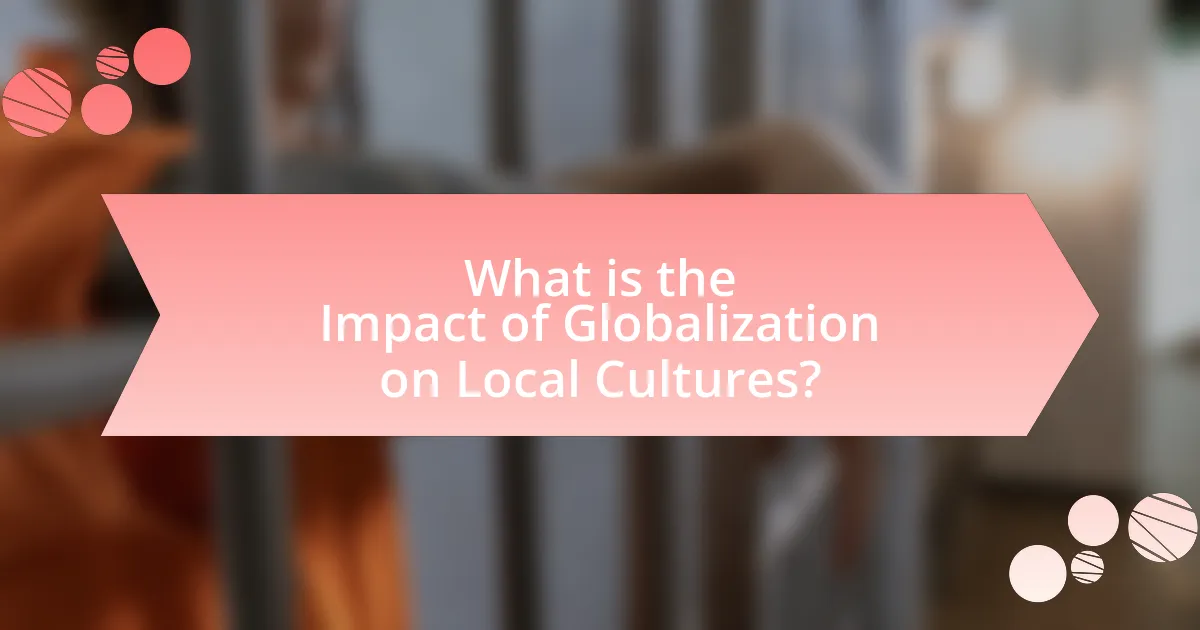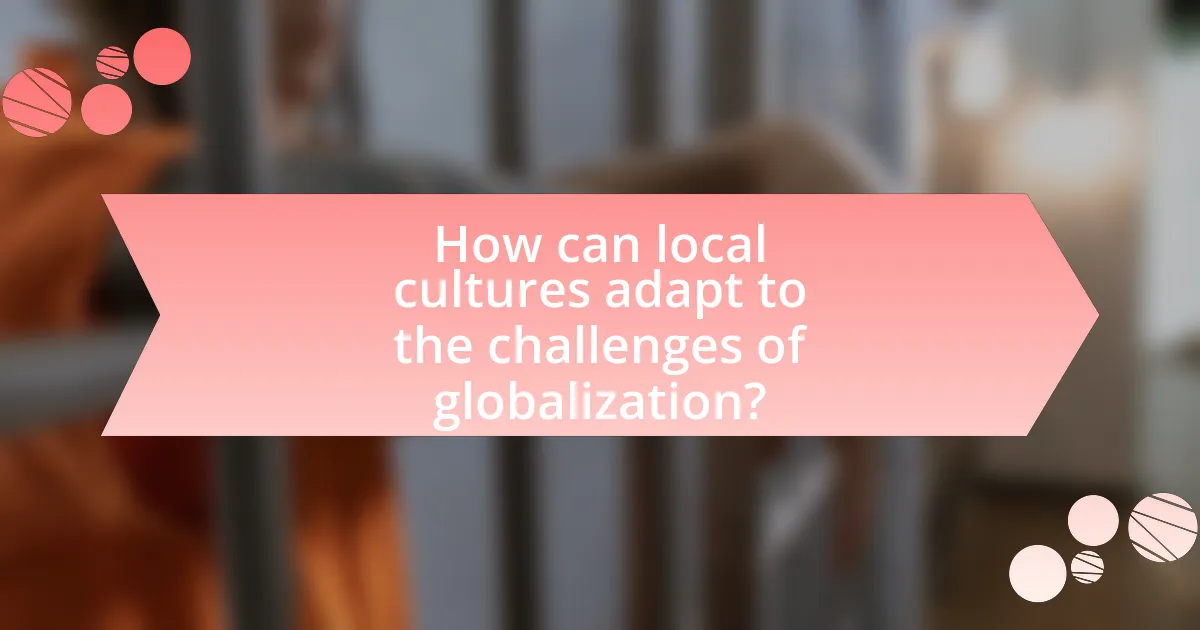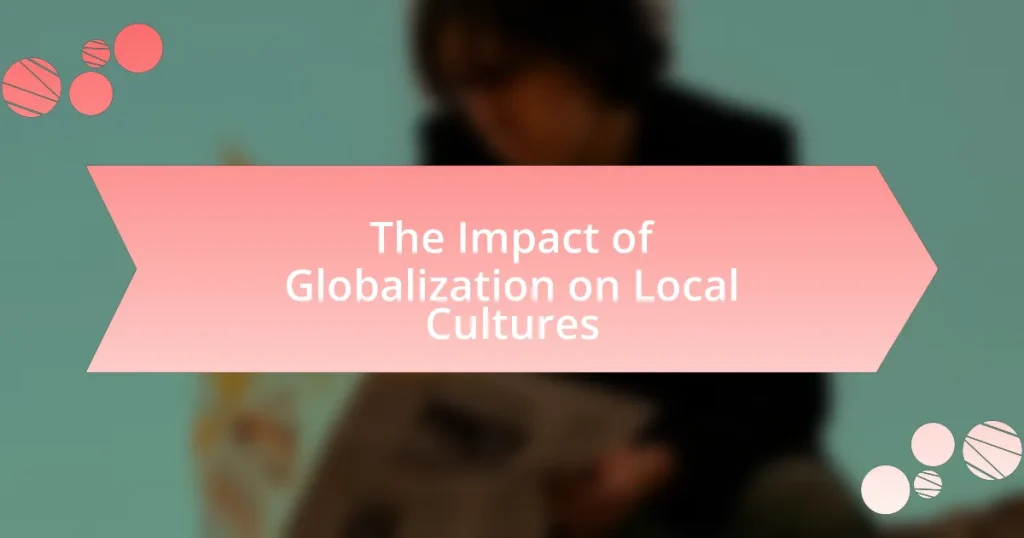The article examines the impact of globalization on local cultures, highlighting both the positive and negative consequences. It discusses how globalization promotes cultural homogenization, leading to the erosion of local customs, languages, and identities, with approximately 40% of the world’s languages at risk of extinction. The article also explores how local communities respond to these changes through adaptation, resistance, and revitalization efforts, while emphasizing the role of technology in enhancing cultural visibility and exchange. Additionally, it outlines strategies for preserving cultural heritage and balancing globalization with local authenticity, underscoring the importance of education, community engagement, and supportive policies in maintaining cultural diversity.

What is the Impact of Globalization on Local Cultures?
Globalization significantly impacts local cultures by promoting cultural homogenization and diminishing cultural diversity. As global communication and trade increase, local customs, traditions, and languages often face erosion due to the dominance of global brands and media. For instance, the widespread availability of Western media has led to the adoption of Western lifestyles and values in many non-Western societies, resulting in a decline in indigenous practices. According to a study by the United Nations Educational, Scientific and Cultural Organization (UNESCO), approximately 40% of the world’s languages are at risk of disappearing, largely due to globalization’s influence on local cultures. This evidence illustrates how globalization can lead to a loss of cultural identity and heritage.
How does globalization influence cultural identity?
Globalization influences cultural identity by facilitating the exchange of ideas, values, and practices across different societies, leading to both cultural homogenization and the emergence of hybrid identities. This process is evident in the widespread adoption of global brands, media, and technology, which often overshadow local traditions and customs. For instance, the proliferation of Western media has significantly impacted youth culture worldwide, resulting in a shared global culture that can dilute distinct local identities. Additionally, globalization allows for the blending of cultural elements, as seen in the fusion of culinary practices or music genres, creating new cultural expressions that reflect both local and global influences.
What are the key elements of cultural identity affected by globalization?
The key elements of cultural identity affected by globalization include language, traditions, values, and social practices. Globalization facilitates the spread of dominant cultures, often leading to the erosion of local languages as seen in UNESCO’s reports indicating that nearly 40% of languages are endangered due to globalization. Additionally, traditional customs and rituals may diminish as global consumer culture promotes homogenized lifestyles, evidenced by the rise of fast food chains that overshadow local cuisines. Values such as community and familial ties can weaken as individualism becomes more prevalent, reflecting a shift towards Western ideals. Social practices, including festivals and communal gatherings, may also decline as global connectivity encourages virtual interactions over face-to-face community engagement.
How do local communities respond to changes in their cultural identity?
Local communities respond to changes in their cultural identity through adaptation, resistance, and revitalization efforts. Adaptation occurs as communities integrate new cultural elements while maintaining core traditions, often leading to hybrid cultural expressions. Resistance manifests in the preservation of traditional practices and values, as seen in movements that advocate for cultural heritage protection. Revitalization efforts involve initiatives aimed at reclaiming and promoting local customs, languages, and arts, which can be observed in various cultural festivals and educational programs. For instance, the revitalization of indigenous languages in Canada demonstrates a community’s proactive approach to preserving cultural identity amidst globalization pressures.
What are the positive effects of globalization on local cultures?
Globalization positively affects local cultures by facilitating cultural exchange and promoting diversity. This exchange allows local cultures to incorporate new ideas, practices, and art forms, enriching their own traditions. For instance, the global spread of music genres like jazz and hip-hop has influenced local music scenes worldwide, leading to unique fusions that reflect both local and global elements. Additionally, globalization encourages the preservation of local languages and customs as communities gain access to international platforms that celebrate their heritage, such as cultural festivals and digital media. According to a study by the United Nations Educational, Scientific and Cultural Organization (UNESCO), cultural diversity is enhanced through globalization, as it fosters mutual understanding and respect among different cultures.
How does globalization promote cultural exchange?
Globalization promotes cultural exchange by facilitating the flow of ideas, goods, and people across borders. This interconnectedness allows diverse cultures to interact, share traditions, and influence one another. For instance, the rise of the internet and social media has enabled individuals from different cultural backgrounds to communicate and collaborate, leading to the blending of cultural practices and the emergence of global cultural phenomena, such as music genres and culinary trends. According to a report by the United Nations Educational, Scientific and Cultural Organization (UNESCO), cultural exchanges foster mutual understanding and respect among nations, highlighting the importance of cultural diversity in a globalized world.
What role does technology play in enhancing cultural visibility?
Technology significantly enhances cultural visibility by providing platforms for diverse cultural expressions and facilitating global access to cultural content. Digital tools such as social media, streaming services, and online galleries allow individuals and communities to share their cultural heritage widely, reaching audiences that were previously inaccessible. For instance, platforms like YouTube and Instagram enable artists and cultural practitioners to showcase their work to a global audience, thereby increasing awareness and appreciation of various cultures. According to a report by the Pew Research Center, 72% of adults in the U.S. use social media, which amplifies the visibility of cultural narratives and traditions. This democratization of cultural representation fosters greater understanding and dialogue among different cultural groups, ultimately enriching the global cultural landscape.

What are the negative consequences of globalization on local cultures?
Globalization negatively impacts local cultures by leading to cultural homogenization, where unique cultural identities are diminished in favor of a dominant global culture. This phenomenon is evidenced by the widespread adoption of Western consumer habits, media, and values, which often overshadow traditional practices and languages. For instance, UNESCO reports that nearly half of the world’s languages are at risk of disappearing, largely due to the influence of globalization, which favors more dominant languages like English and Spanish. Additionally, local customs and traditions may be commercialized or altered to cater to global markets, further eroding their authenticity and significance.
How does globalization lead to cultural homogenization?
Globalization leads to cultural homogenization by facilitating the widespread exchange of ideas, values, and practices across borders, resulting in a convergence of cultures. This process is driven by advancements in technology, communication, and trade, which enable global brands and media to dominate local markets. For instance, the proliferation of multinational corporations and global media outlets often promotes a standardized culture, exemplified by the global popularity of fast food chains and Hollywood films, which can overshadow and diminish local cultural expressions. Studies indicate that as societies become more interconnected, unique cultural identities may erode, leading to a more uniform global culture.
What examples illustrate the loss of unique cultural practices?
The loss of unique cultural practices is illustrated by the decline of indigenous languages and traditional rituals. For instance, the number of speakers of indigenous languages in North America has drastically decreased, with estimates suggesting that over 90% of these languages are at risk of extinction due to globalization and cultural assimilation. Additionally, traditional practices such as the Maori Haka in New Zealand have seen diminished authenticity as they are often performed in commercial contexts, losing their original cultural significance. These examples highlight how globalization can lead to the erosion of distinct cultural identities and practices.
How does the dominance of global brands affect local traditions?
The dominance of global brands significantly undermines local traditions by promoting homogenization of culture. As global brands expand, they often prioritize standardized products and marketing strategies that overshadow unique local customs and practices. For instance, the proliferation of fast-food chains has led to a decline in traditional culinary practices in various countries, as seen in the reduction of local food consumption in favor of Western-style diets. Research indicates that in countries where global brands dominate, there is a measurable decrease in the use of local languages and traditional art forms, as these brands often favor a universal appeal over cultural specificity. This trend not only dilutes cultural identity but also impacts local economies, as traditional artisans and businesses struggle to compete with the pricing and marketing power of global corporations.
What impact does globalization have on language and communication?
Globalization significantly influences language and communication by promoting the spread of dominant languages, particularly English, while simultaneously leading to the decline of local languages. This phenomenon is evidenced by the fact that over 7,000 languages are spoken worldwide, yet many are at risk of extinction due to the increasing prevalence of global languages in media, education, and business. For instance, a study by the Linguistic Society of America indicates that one language dies approximately every two weeks, often as communities shift towards more globally recognized languages for economic and social opportunities. Consequently, while globalization facilitates cross-cultural communication and access to information, it also threatens linguistic diversity and the cultural identities tied to local languages.
How does the spread of a global language affect local dialects?
The spread of a global language often leads to the erosion of local dialects. As global languages like English become dominant in education, media, and business, speakers of local dialects may shift towards the global language for social and economic advantages. This shift can result in decreased usage of local dialects, leading to their gradual decline or even extinction. For instance, UNESCO has reported that over 40% of the world’s languages are endangered, many of which are local dialects overshadowed by global languages.
What are the implications of language loss for cultural heritage?
Language loss significantly undermines cultural heritage by erasing unique worldviews, traditions, and histories embedded in languages. When a language disappears, the specific knowledge, practices, and cultural expressions associated with that language often vanish as well, leading to a homogenization of cultural identities. For instance, UNESCO estimates that over 40% of languages are endangered, which correlates with the loss of traditional ecological knowledge and cultural practices that are often transmitted orally. This loss not only diminishes the diversity of human expression but also impacts community cohesion and identity, as language is a key component of cultural belonging.

How can local cultures adapt to the challenges of globalization?
Local cultures can adapt to the challenges of globalization by actively preserving their unique traditions while integrating beneficial aspects of global influences. This dual approach allows communities to maintain their cultural identity, as seen in various regions where local festivals and languages are promoted alongside the adoption of new technologies and practices. For instance, in Japan, traditional arts like tea ceremonies coexist with modern innovations, demonstrating a successful blend of old and new. Additionally, local cultures can leverage globalization by participating in global markets, which can enhance economic opportunities while fostering cultural exchange. This adaptability is crucial for sustaining cultural heritage in an increasingly interconnected world.
What strategies can communities employ to preserve their cultural heritage?
Communities can employ several strategies to preserve their cultural heritage, including documentation, education, and community engagement. Documentation involves recording oral histories, traditional practices, and local languages, which helps maintain cultural narratives. Education initiatives can incorporate local history and cultural practices into school curricula, fostering appreciation among younger generations. Community engagement through festivals, workshops, and cultural events encourages participation and strengthens communal ties, ensuring that cultural practices are actively practiced and passed down. These strategies are supported by research indicating that active participation and education significantly enhance cultural preservation efforts, as seen in various case studies worldwide.
How can education play a role in cultural preservation?
Education plays a crucial role in cultural preservation by imparting knowledge about cultural heritage, traditions, and languages to new generations. Through curricula that include local history, folklore, and traditional practices, educational institutions foster an appreciation for cultural identity. For instance, UNESCO emphasizes the importance of education in safeguarding intangible cultural heritage, highlighting that educational programs can enhance community awareness and engagement in cultural practices. This structured approach not only helps maintain cultural diversity but also counters the homogenizing effects of globalization, ensuring that local cultures remain vibrant and relevant.
What initiatives can promote local arts and traditions in a globalized world?
Initiatives that can promote local arts and traditions in a globalized world include cultural exchange programs, local art festivals, and community-based workshops. Cultural exchange programs facilitate interaction between local artists and international counterparts, fostering appreciation and collaboration. Local art festivals showcase traditional crafts, music, and performances, attracting both locals and tourists, which helps sustain these art forms economically. Community-based workshops engage residents in traditional practices, ensuring skills are passed down through generations. For example, UNESCO’s Intangible Cultural Heritage program supports the preservation of local traditions by recognizing and promoting cultural practices globally, demonstrating the effectiveness of such initiatives in maintaining cultural identity amidst globalization.
What are some best practices for balancing globalization and local culture?
Best practices for balancing globalization and local culture include promoting cultural exchange, supporting local businesses, and implementing policies that protect cultural heritage. Cultural exchange programs foster understanding and appreciation of local traditions while integrating global perspectives. Supporting local businesses helps maintain economic stability and encourages the preservation of unique cultural practices. Policies that protect cultural heritage, such as regulations on foreign investments and tourism, ensure that local identities are not overshadowed by global influences. These practices are essential for maintaining cultural diversity in an increasingly interconnected world.
How can local businesses thrive while maintaining cultural authenticity?
Local businesses can thrive while maintaining cultural authenticity by integrating traditional practices into their operations and marketing strategies. This approach allows them to attract customers who value unique cultural experiences. For instance, businesses can offer locally sourced products that reflect regional heritage, thereby fostering community support and loyalty. Research indicates that 78% of consumers prefer brands that demonstrate cultural awareness and authenticity, which can lead to increased sales and customer retention. By prioritizing cultural elements in their branding and customer engagement, local businesses can differentiate themselves in a globalized market while preserving their unique identity.
What role do policymakers play in supporting cultural diversity amidst globalization?
Policymakers play a crucial role in supporting cultural diversity amidst globalization by implementing regulations and initiatives that protect and promote local cultures. They create policies that encourage the preservation of cultural heritage, such as funding for cultural programs, support for local artists, and the establishment of cultural education in schools. For instance, UNESCO’s Convention on the Protection and Promotion of the Diversity of Cultural Expressions, adopted in 2005, emphasizes the importance of cultural diversity and encourages member states to develop policies that foster cultural expression. By enacting such policies, governments can mitigate the homogenizing effects of globalization, ensuring that diverse cultural identities are maintained and celebrated.
What practical steps can individuals take to support local cultures in a globalized world?
Individuals can support local cultures in a globalized world by actively engaging in and promoting local traditions, arts, and businesses. This can be achieved by attending cultural events, such as festivals and workshops, which help preserve and showcase local heritage. Supporting local artisans and businesses by purchasing handmade goods and services directly contributes to the economic sustainability of these cultures. Additionally, individuals can educate themselves and others about the significance of local customs and practices, fostering appreciation and respect for cultural diversity. Research indicates that communities that engage in cultural preservation activities experience enhanced social cohesion and economic benefits, reinforcing the importance of individual actions in supporting local cultures amidst globalization.
